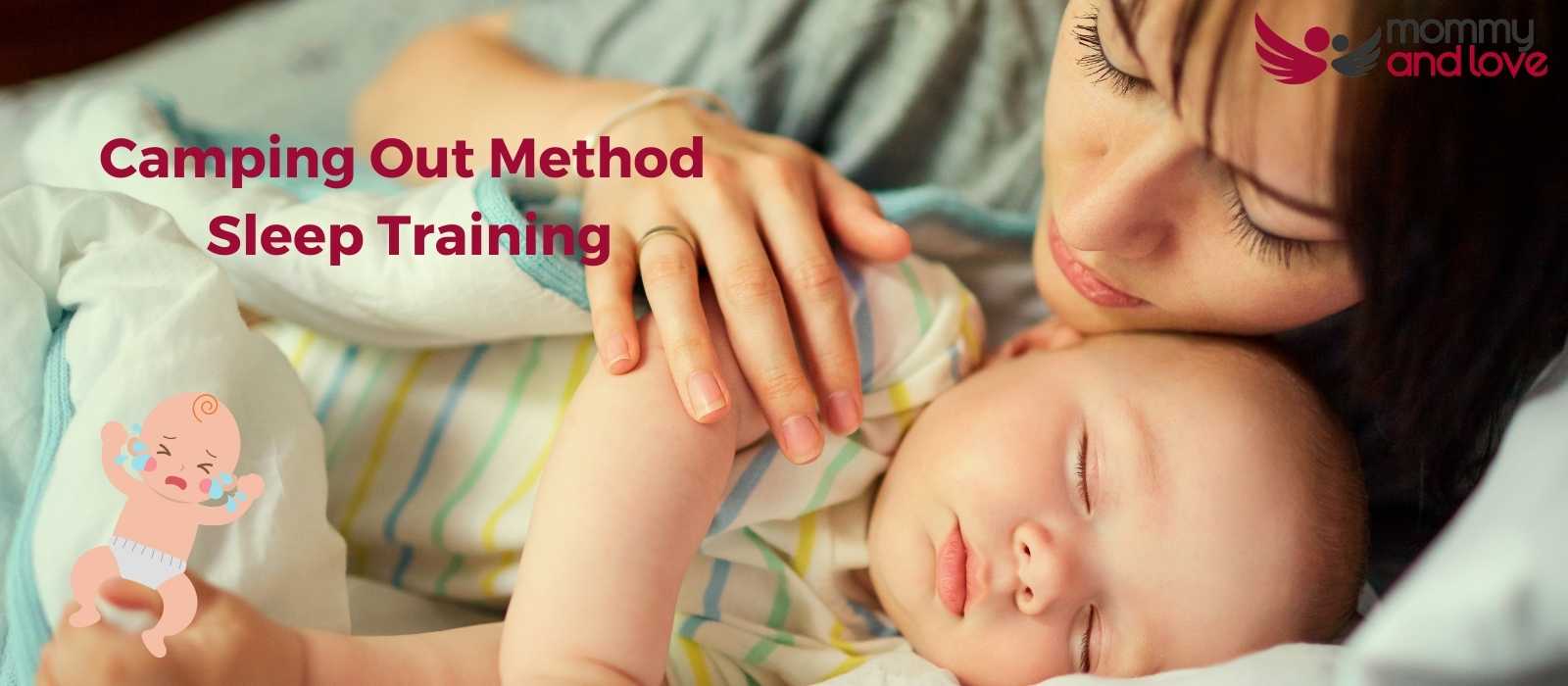Do you have a fussy baby that won’t sleep through the night? Are you at your wit’s end? Well, have no fear – the camping out method of sleep training may be just what you need!
This technique is based on the idea of “extinction” sleep training, which means that you are gradually weaning your baby off of nighttime feedings. It can be a little bit tough to stick to, but it is definitely worth it in the end!
What Is Camping Out Sleep Training?
There are a lot of different sleep training methods and gentle alternatives out there. Some are more gentle than others, and some are more hands-off. Camping out sleep training (sometimes called the chair method) is somewhere in the middle – it’s not as gentle as, say, the Ferber method, but it’s also not as hands-off as the cry-it-out method.
So, what is camping out sleep training? Essentially, it’s when you camp out next to your child’s crib or bed (hence the name), and you provide reassurance and support as they fall asleep. You stay in the room until they’re asleep, and then you leave.
The goal of camping out sleep training is to help your babies learn to fall asleep on their own, without you having to be in the room. It’s a more gradual approach than cry-it-out, and it can be less stressful for both you and your babies, especially during the early years.
Most camping out sleep training programs recommend starting when your child is around six months old. That said, every child is different, so if you think your babies might be ready sooner (or if they’re not quite ready for cry-it-out), camping out might be a good option for parents.
Things to Consider With the Camping Out Sleep Training Method
If you’re interested in trying camping out sleep training, there are a few things to keep in mind.
First, it’s important to be consistent – try to do it every night, at the same time.
Second, it might take a few nights for your child to get used to the idea of sleeping without you in the room, so don’t get discouraged if they cry or protest at first.
And finally, remember that every child is different, and what sleeping method works for one baby might not work for another. And the only way to find out is to try.
If camping out doesn’t seem to be working after a few nights, it’s okay to try something else. For instance, you can create a good sleeping environment for your babies by making sure they’re not surrounded by blankets or stuffed animals. Use recordings of soft music as well as provide parental presence when necessary.
What Is the Cry It Out Method?

Cry it out (CIO method), also known as “controlled crying,” is a sleep-training technique that involves letting your baby cry until they fall asleep.
The idea is that by teaching your baby to soothe himself, they’ll learn to fall asleep on their own – without needing you to rock them, feed them to sleep or without sleep associations.
Now, this method isn’t for everyone. Some parents find the thought of letting their baby cry unbearable. And that’s totally understandable! But if you’re considering the cry it out, it’s important to know how it works, what the pros and cons are, and whether or not it’s right for your family.
Here’s what you need to know about the cry it out:
How It Works
The cry it out is usually implemented in one of two ways:
With “graduated extinction,” you allow your baby to cry for gradually increasing intervals of time before you respond. For example, you might let them cry for five minutes the first night, ten minutes the second night, and so on.
With ” Ferberizing,” you let your baby cry for a set amount of time (usually three to five minutes) before going in to comfort them. You then increase the intervals between each comforting session by a few minutes each time.
The Pros
There are a few advantages to using the cry it out:
- It can be an effective way to let your baby have a nighttime sleep.
- It can help your baby learn how to self-soothe and fall asleep on their own (without the help of either mom or dad).
- It can give you a much-needed break! If you’re struggling to cope with sleep deprivation, the cry it out can give you a chance to get some much-needed rest.
The Cons
Of course, there are also a few drawbacks to using the cry it out:
- It can be hard to listen to your baby crying. If you have a sensitive temperament, the cry it out may not be right for you.
- It can take a few days or even weeks before your baby falls asleep on her own using the cry it out. In the meantime, you can expect some sleepless nights.
- Your baby may have more difficulty falling back asleep if they wake up in the middle of the night. Since they’ve learned to self-soothe and fall asleep on their own, they may not know how to get back to sleep if they wake up in the middle of the night.
If you’re struggling to cope with sleep deprivation, or if you feel like you’ve tried everything else and nothing has worked, the cry it out may be worth a try. Just be sure to go into it with your eyes open, and be prepared for some tough nights.
What Is the Most Effective Sleep Training Method to Make a Child Sleep?

to Make a Child Sleep?
There is no one answer to this question as different sleep training methods work for different families.
Some of the most popular sleep training to make a baby sleep and improve infant sleep problems include cry it out (CIO methods), controlled crying, Ferber method (progressive waiting approach), bedtime fading and gentle sleep training.
The most important thing is to find a method that works for you and your family. If one method doesn’t work, don’t be afraid to try another. The most important thing is to let your child have better sleep.
What Is the Gentlest Sleep Training Method to Make a Baby Sleep?
There are a few different sleep training methods to sleep train your baby, and each has its own advantages and disadvantages. Some parents prefer the “cry it out” method, while others find the gradual approach to be a gentle alternative for younger babies.
So, what is the gentlest sleep training method to make a baby sleep? That really depends on your definition of “gentle.” If you’re looking for a method that will help your baby learn to sleep through the night with minimal crying, then the gradual approach may be best. But if you’re okay with your baby crying for a little while in order to learn to self-soothe.
Ultimately, there is no right or wrong answer when it comes to sleep training. It’s important to do what feels right for you and your family. But you also have to consider your child’s temperament and readiness.
At What Age Should a Child Fall Asleep on Their Own?

It’s a question that many parents ask themselves, and there is no easy answer. Every child is different and will develop falling asleep independently at their own pace.
There are, however, some general guidelines that can help you decide when it’s appropriate to start your child on the path to independent sleep.
One important factor to consider is your baby’s age. For infants, it’s perfectly normal for them to sleep with their parents. In fact, it’s often recommended by doctors and experts. This is because newborns need a lot of care and attention, and they can benefit from being close to their parents.
As your child gets older, though, you may start to feel like it’s time to let your baby fall asleep independently. This is usually around the age of one or two. At this point, your child is starting to develop a sense of independence and may be able to go longer periods without needing your help. Additionally, at this age, they have been fully weaned off night feeds.
Of course, every family is different and there is no wrong answer here. Whatever you decide, the most important thing is that your child feels safe, loved, and supported. With that in place, they’ll be able to have healthy sleep – no matter where they are.
What Is the Best Age for Sleep Training?
Infant sleep training is a process of helping your child learn to sleep through the night or falling asleep on their own. And in some cases, it helps solve a child’s sleep problems. Many parents begin infant sleep training when their child is around six months old.
However, some professional sleep consultants and sleep coaches believe that toddler sleep training should be started sooner, while others believe it can wait until later. So, what is the best age for sleep training or sleep coaching?
There is no one answer to this question. Every child is different and will respond to sleep training in their own way. Some young children may be ready for more sleep training or sleep coaching as early as four months old, while others may not be ready to learn independent sleep skills until they are closer to nine months old.
And if your child has sleep problems, additional behavioral treatment might be needed.
Ultimately, the best age for sleep training or sleep coaching is whenever your child is developmentally ready and you are comfortable with the process of developing a consistent bedtime routine and regular sleep patterns.
You can also talk to a certified sleep consultant, sleep specialist or sleep coach to help with your baby’s sleep challenges and night wakings and help the entire family sleep better and find the best bedtime routine. One popular online service is the Baby Sleep Site.
Conclusion
The Camping Out Method is a gradual sleep training technique that can be tough to stick to, but it’s definitely worth it in the end. If you’re looking for a way to get your baby to sleep through the night without all of the fuss, this might just be the solution for you. And if you want to explore more options, you can always talk to a sleep expert. Good luck and happy camping!




